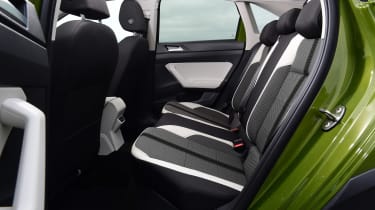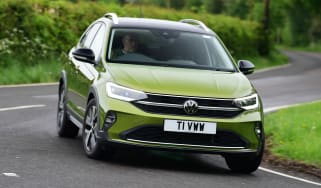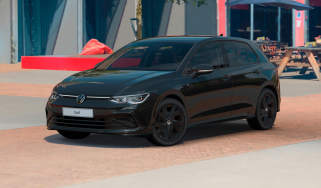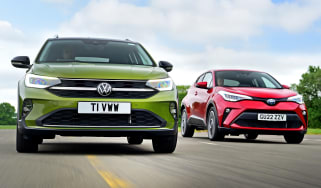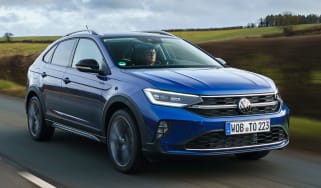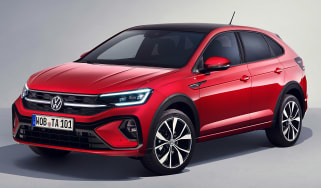Volkswagen Taigo review: a stylish coupe-SUV with matching substance
The Volkswagen Taigo is a stylish coupe-SUV that doesn’t compromise on practicality

The Volkswagen Taigo is based on the more upright-looking T-Cross, but it features smoother lines and a lowered stance. In contrast to its sleek appearance, the Taigo still comes with enough space and flexibility to appeal to family buyers. So, if you’re after a reasonably practical compact SUV, but also want something that reflects your smart, sophisticated side, then the Volkswagen Taigo could be for you.
It’s not particularly fun to drive, although it’s certainly easy on the eye and this, combined with the typical VW traits of decent build quality, good levels of standard equipment and reasonable efficiency, mean that it will prove to be a convincing package for some.
About the Volkswagen Taigo
Coupe-SUVs are often criticised for being more expensive than the regular SUVs on which they’re based, even though they are technically less fit for purpose. They may look curvier and more stylish than a traditional SUV, but they’re also less practical as a result. Many examples are also more expensive to buy than the standard model.
Those who are in favour of the coupe-SUV, though, are buying them up in droves. Ever since BMW kicked off the craze with the original X6 back in 2008, several premium manufacturers, including Audi and Mercedes, have applied this strategy to a raft of their own models and achieved decent sales success.
Used - available now

2024 Volkswagen
Taigo
8,000 milesManualPetrol1.0L
Cash £16,995
2025 Volkswagen
Taigo
5,616 milesAutomaticPetrol1.0L
Cash £22,999
2026 Volkswagen
Taigo
38,927 milesManualPetrol1.0L
Cash £13,572
2024 Volkswagen
Taigo
11,704 milesManualPetrol1.0L
Cash £17,753So why are these seemingly flawed models so popular? Well, the fickle finger of fashion has a lot to answer for. Not satisfied with your Audi Q5? Try the Q5 Sportback - it’ll change your life.
This success hasn’t gone unnoticed by the mainstream brands, though, hence the arrival of the Volkswagen Taigo. Of course, buyers with smaller budgets might not have fashion quite as high on their list of priorities when buying a car, so VW has worked hard to keep plentiful passenger space, boot capacity and overall practicality firmly on the agenda.
Offering more kerb appeal than the sensible, solid T-Cross, with which it shares its mechanical makeup, the Taigo crucially doesn’t give up too much in the way of day-to-day usability. Yes, it’s more expensive to buy, although you don’t feel like you’re being short-changed, as you might with some other models. It’s 150mm longer than the T-Cross, too, so there’s ample cabin space, while boot capacity remains pretty generous.
Volkswagen has elected to keep power fairly moderate for the Taigo. A 1.0-litre, three-cylinder TSI petrol engine is available with either 94bhp or 108bhp, while a range-topping 1.5-litre TSI unit offers 148bhp.
The entry-level 94bhp model is paired solely with a five-speed manual gearbox, while moving up to the 108bhp version — our recommended choice — gives you the choice of a six-speed manual or seven-speed DSG automatic transmission. The larger 148bhp 1.5-litre is fitted with the DSG auto as standard.
The trim level lineup is equally simple: Life, Style and R-Line. While the standard kit is fine, you’ll benefit from upgrading to the Style specification, which offers extras such as bigger 17-inch alloy wheels, sports seats, integrated sat-nav, and VW’s 10.25-inch Digital Cockpit Pro instrument display.
Starting from around £26,000, the Taigo is significantly cheaper than other stylish rivals such as the Toyota C-HR and Peugeot 408, although the capable Kia XCeed and fun-to-drive Ford Puma manage to undercut it.
Engines, performance and drive
Buyers shouldn’t be fooled into thinking that the stylish, sporty-looking Taigo comes with extra performance credentials over its T-Cross sibling. There’s no hot R model at the top of the range, with only 1.0 and 1.5-litre TSI petrol engines to choose from – the most powerful providing 148bhp.
Ultimately, this reflects the true character of Volkswagen’s small coupe-SUV; a leisurely, laid-back cruiser that brings a little more elegance to everyday driving. There’s a focus on overall stability and comfort, although there’s a bit more road noise than we’d like and a fidgety ride at lower speeds.
Most of the Taigo’s life will arguably be spent in and around town and on urban commutes, so it perhaps seems odd that in the manual vs automatic gearbox debate, we’d recommend the manual. We found the auto to be jerky when attempting to park, and also a bit hesitant when pulling away from junctions – not ideal traits if you spend a lot of time navigating the hustle and bustle of busy streets.
However, the Taigo is perfectly pleasant at motorway speeds, and the 108bhp 1.0-litre engine is responsive enough. Opting for the 148bhp 1.5-litre unit does add an additional 50Nm of torque, though, which helps to make overtaking that bit easier.
0-62mph acceleration and top speed
The Taigo lineup relies on a selection of Volkswagen’s entry and mid-range TSI petrol engines to power the coupe-SUV. The entry 94bhp 1.0-litre version is capable of 0-62mph in a sluggish 11.1 seconds, although upgrading to the 108bhp variant means the sprint time falls to 10.4 seconds (in six-speed manual form).
There’s decent pace to be found in the 148bhp 1.5-litre R-Line model, which manages 0-62mph in 8.3 seconds and a top speed of 132mph.
MPG, CO2 and running costs
You’ll pay a little more for the stylish Taigo than its more conventional T-Cross sibling, with entry models for each range separated by around £2,000. Both use the same frugal TSI petrol engines, with the 108bhp 1.0-litre (six-speed manual) unit being the most efficient in the lineup.
It manages a claimed WLTP maximum of 52.3mpg, which betters the 51.8mpg of the 94bhp 1.0-litre version, although both emit 123g/km of CO2. Pairing the 108bhp car with the DSG automatic transmission means fuel economy falls slightly to 48.3mpg with CO2 emissions of 133g/km.
No variant of the Taigo is particularly thirsty for fuel, and even the range-topping R-Line fitted with the 1.5-litre TSI engine and seven-speed DSG gearbox returns up to 48.5mpg on the WLTP combined cycle. Its CO2 emissions of 132g/km aren’t even the highest in the line-up.
Insurance
The entry 94bhp 1.0-litre Life model should be relatively cheap to insure because it occupies insurance group 13E (out of 50) — the letter E denotes that the Taigo exceeds the security requirements for this type of car, resulting in a lower insurance group. Upgrading to the 108bhp Life version sees a slight increase to group 14E, while combining this more powerful engine with the mid-range Style specification sees a further rise to group 16E.
Opting for the 148bhp 1.5-litre engine with either the R-Line or Style trim means you’ll pay the most for insurance, as these sit in groups 22E and 23E, respectively.
Check if your car needs an MoT and view its complete history with our MoT History Checker...
Depreciation
Volkswagen cars tend to perform strongly across the used market, and the Taigo coupe-SUV is no exception. After a typical three-year/36,000-mile ownership period, our expert data suggests it should retain between 50.20 and 52.55 per cent of its original showroom value. In comparison, the VW T-Cross fares slightly worse, holding onto 47.02 to 53.55 per cent of its list price after the same three-year period and mileage.
To get an accurate valuation on a specific model check out our free car valuation tool…
Interior, design and technology
The Taigo shares its underpinnings with the Volkswagen T-Cross, which is based on the MQB A0 architecture that also forms the base of smaller cars such as the Polo supermini. Volkswagen has smoothed out the boxy lines of the T-Cross to create a more stylish, coupe look for the Taigo.
With a sloping roofline, lower bonnet and a 66mm reduction in height over the T-Cross, the Taigo will look smart on the school run, and has that extra kerb appeal that is so important across UK suburban streets. But it’s not all form over function; the Taigo is longer than the model it's based on, which helps keep interior space up to par.
The cabin doesn’t throw up too many surprises as the dash is lifted straight from the T-Cross, although there is the option to customise the look with a painted finish to match the car’s body colour. Softer materials are used higher on the dashboard and door cards, with lower grade plastics evident lower down, while opting for a lighter interior trim colour does help to lift the ambience.
The standard kit is reasonable, although we’d recommend the mid-range Style trim as the sweet spot in the range. One bugbear is VW’s insistence on continuing with touch-sensitive climate controls, which are simply a nuisance to use on the move and are positioned too low to be within easy reach. A return to physical dials would be most welcome in our view.
Sat-nav, stereo and infotainment
The Taigo’s Discover Media set-up is a familiar one that’s hard to find fault with. The main menu is neatly laid out with a selection of tiles, while the screen is flanked by a set of touch-sensitive shortcut keys and physical knobs for the volume and navigation zoom functions, so it’s easy to find what you choose.
VW’s built-in navigation loads quickly enough, and a proximity sensor brings up certain functions when you move your hand toward the display, so the screen is uncluttered when you don’t need them. Loading times are fine, although the screen lags slightly when swiping through the menus.
The Taigo gets a digital driver’s display with an eight-inch set-up used on the base model, and a 10.25-inch system for the Style and R-Line versions. On the latter version, you can switch between screens to show various bits of information, such as navigation instructions and driver assistance information. If all that scares you, don’t worry – there’s a screen with conventional-looking dials, too.
Practicality, comfort and boot space
Despite offering a style upgrade over its T-Cross sibling, the Taigo doesn’t disappoint in terms of overall practicality. Interior space is good, while the standard kit includes adaptive cruise control, automatic headlights, power-folding heated mirrors and a wireless smartphone charging function. Further up the range you’ll find additional features such as upgraded sports comfort seats, dual-zone climate control, and integrated sat-nav.
A small grumble is that we didn’t like the design of the two cup holders between the front seats. They’re shaped hexagonally and struggle to hold anything more than a small coffee cup. It’s an odd feature in an otherwise ergonomically sound interior.
Family car buyers will be pleased to see ISOFIX points in the front and rear passenger seats; they’re easy to reach, with access made all the easier by the large rear door opening.
Dimensions and size
The Taigo is 4,266mm long and 1,757mm wide (excluding mirrors), which means it's a little longer than the T-Cross, although not quite as wide.
Leg room, head room & passenger space
Volkswagen has done an excellent job of ensuring that the Taigo’s sloping roofline doesn’t impact headroom for rear passengers, while legroom is good throughout the cabin. Space upfront is not dissimilar to the T-Cross, meaning it should be fine for most.
Boot space
At 440 litres, the Taigo’s boot capacity is only 15 litres down on the T-Cross, although it’s still well ahead of its Toyota C-HR rival, which offers a maximum load space of 377 litres.
Adding to the Taigo’s practicality is the large tailgate opening, low load lip and adjustable boot floor. Folding the rear seats unlocks a total of 1,222 litres.
Towing
If you’re prioritising towing ability, then the 148bhp 1.5-litre TSI is the engine to go for. It is rated to tow up to 1,200kg, while the 108bhp 1.0-litre limit is 1,100kg, followed by the 94bhp version with a maximum braked trailer load of 1,000kg.
Reliability and safety
Safety levels for the Taigo are among the best in its class, underpinned by the coupe-SUV’s five-star Euro NCAP crash-test rating that it received in 2022. It scored 94 per cent for adult occupant safety and 84 per cent for child passenger protection, while the Taigo’s safety assist systems achieved 70 per cent.
All Taigo models feature Adaptive Cruise Control, a driver fatigue alert, autonomous emergency braking, a Side Assist function which monitors blind spots while driving and a Travel Assist system, which offers a level of semi-autonomous driving using onboard, radar-based cameras. For those who find parking a chore, Park Assist helps with parallel or bay parking.
The Taigo has yet to appear in our Driver Power customer satisfaction survey, although in 2023, the T-Cross on which it’s based ranked 21 out of the top 75 best cars to own. Volkswagen itself finished in the 27th spot out of 32 brands in the manufacturer ratings, which was a poor result.
Warranty
A standard three-year/60,000-mile warranty for the Taigo is reasonable, but not as good as you’ll find with rivals such as the Toyota C-HR. That rival benefits from up to ten years of cover.
Servicing
Volkswagen offers various servicing plans for the Taigo to help spread the cost of scheduled maintenance. A standard plan (for cars under one-year old) includes two consecutive services for an upfront payment of £492, or 24 monthly instalments of £20.50.


